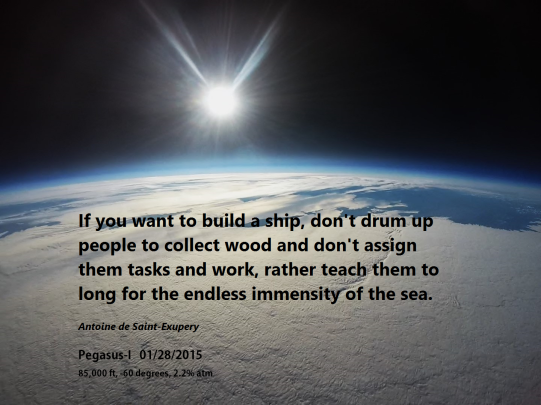It was 11/07/2014 when I sent an email to Mark Nichols, my partner in this adventure, which contained on the subject line “Must do this” and a link in the body of the message. About 5 minutes later a simple response, “Absolutely”. The Pegasus Mission was born, a real-time IOT experiment in the upper atmosphere with a high altitude balloon (HAB) as a delivery system.
The first days of imagining this experiment we documented a simple set of goals and technical objectives:
- A photo of the curvature of the Earth, the edge of the atmosphere, and the blackness of space.
- Real-time telemetry stream of metrological information and location.
- Demonstrate real-time control over the in-flight craft.
- Make others participants in the flight through real-time broadcasting of the telemetry.
- Survive (implicit goal)
Pegasus is truly an intersection of STEM fields, where the “T” is only a part of the equation. There is a considerable amount of engineering involved to make it tangible, to make it fly, to recover the craft, and get communications with the craft in real-time (milliseconds). Mark knows devices and is a craftsman with mechanical things. He can design the electrical systems, the communications packages, and craft the payload and its mechanical devices. I would take care of the aeronautical engineering of the flight and the Operational Technology. We would cross multiple fields from electrical, mechanical, aeronautical, even civil engineering and coupling that with cloud services and an Operational Technology, Piraeus, truly on the frontiers boundaries of what is possible. AFAIK, the first real-time broadcast of IOT technology from the upper atmosphere of our planet.
You could put a payload on a high altitude balloon and with some tools on the Internet likely make it fly. However, you would not know what was going to happen. Its challenge rooted in the hostile environment of the upper atmosphere. We could cover the basics and understand the flight dynamics, but you cannot test something with plus 200mph wind velocities at minus 60 degrees Fahrenheit in your basement. We would have to do our best engineering, our best craftsmanship, and take our shot.
Mark and I were discussing mission parameters on the phone one day, when I laughed up the idea of releasing the delivery system and plummeting toward the surface of the Earth, only to deploy the parachute just above ground level. Mark said, “A HALO drop. Let’s do that”, to paraphrase. . I told Mark, “if you tell me that you can get that parachute out fast enough, then I am okay with it.” Hurling thousands of dollars of equipment toward the surface of the earth faster than a car can travel was spooky proposition, but compelling. We would go for it.
Complexity was high (probably too high) and time was short. We had until that last week of January 2015 to get Pegasus-1 ready. Only a few months from when we conjured up the experiment from our collective imaginations. Mark was spending nights designing the sensor package and craft, I was trying to work through the aeronautics and prep of Piraeus, our Operational Technology. Sensors, servos, radio transmission, control console, MiFi, Piraeus, and Web site all had to work together, it was serial reliability. If everything does not work, we would lose the craft.
We were constantly buying equipment, regulators, sensors, radio equipment, cameras, antennas, meteorological balloons, parachutes. Weight is the deciding the factor, and has weight began to increase, it got more complex and more equipment was shipped to us. Our “bag” of equipment for launch would weigh about 70 lbs to get the 4 lb payload airborne.
Time had run out and we had a week before the conference. We decided to try for a test flight the week before at a remote grass airfield in Kankakee, IL. Weather conditions were suboptimal, but within range of what we thought possible. There was much work to do, not only did Pegasus-1’s electronics have to work, we would need a software interface between the transmitter/receiver and Piraeus, running in Microsoft Azure. While Mark worked on the payload assembly and testing the electronics, I would work in the software interface. We had feverishly worked 19 hour days completing our respective tasks, but still did not have an integrated system. There were also the logistical considerations, getting the helium, FAA flight advisories, permission for a launch site, etc. It’s not a backyard type of experiment, you have to plan it in advance. Completely exhausted, we had missed our launch window for the test flight. The operation would now move from central Illinois to the conference in Seattle where we would perform our session, then try to fly the following day. The weather forecast was optimal for Othello, WA on 01/28/2015. We would attempt to resolve any remaining issues and get airborne in the treeless environment of eastern Washington State.
-Matt Long
Matt.Long@microsoft.com
